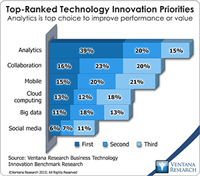Financial management software provider Intacct recently held its seventh annual user conference. In addition to a long list of enhancements in current and upcoming product releases, the company used the occasion to announce Intacct Collaborate, a capability built into its software that enables finance and accounting organizations to work together to answer questions or resolve issues while performing a process. Our benchmark research shows that collaboration ranks second in importance behind...
Read More
Topics:
Performance Management,
Sales Performance,
Salesforce.com,
ERP,
Human Capital Management,
NetSuite,
Office of Finance,
Reporting,
cloud ERP,
Analytics,
Business Analytics,
Business Collaboration,
Business Performance,
Chatter,
Cloud Computing,
Collaboration,
Dashboards,
Financial Performance,
FinancialForce,
Intacct
Salesforce.com made a surprising announcement of its agreement to acquire Rypple, a software company that defines its product as a social goals application. I call this a surprise because although Salesforce has been extending its reach beyond sales and customer service to IT in providing a platform, tools and a database for building applications and storing data in the cloud, until now it has not entered directly into other lines of business. After its annual Dreamforce conference last summer,
Read More
Topics:
Sales Performance,
Salesforce.com,
SAP,
Supply Chain Performance,
Human Capital Management,
Marketing,
Operational Performance,
Business Performance,
Business Technology,
Chatter,
CIO,
Cloud Computing,
Customer & Contact Center,
Information Management,
Oracle,
Workforce Performance,
Business Applications,
CFO,
COO,
CRM,
HR,
SalesCloud,
Service Cloud,
SFA,
Talent Management,
Digital Technology
Tibco recently introduced Spotfire 4.0, the most recent version of its interactive discovery and business intelligence (BI) tool. Spotfire comes at BI through visualization. It uses in-memory processing and good user interface design to develop highly interactive displays of data. Version 4.0 attempts to enhance Spotfire’s dashboard capabilities and offers integration with enterprise collaboration tools. The former capabilities are necessary to broaden Spotfire’s appeal and applicability for...
Read More
Topics:
Sales,
Sales Performance,
Social Media,
Spotfire,
Supply Chain Performance,
Operational Performance,
Business Analytics,
Business Intelligence,
Business Performance,
Chatter,
Collaboration,
Customer & Contact Center,
Dashboards,
Financial Performance,
Tibco,
Twitter,
Workforce Performance
At the Dreamforce conference, Salesforce.com (NYSE:CRM) CEO Marc Benioff unveiled the latest evolution of the company’s strategy and supporting technology for cloud computing and mobile technologies. Its aim is to enable businesses to engage with customers and prospects via social media channels – what Salesforce calls the “social enterprise” – and empower employee and customer social networks to operate individually and together. Note I did not mention CRM, which doesn’t have a role in this...
Read More
Topics:
Mobile,
Sales,
Sales Performance,
Salesforce.com,
Social Media,
Marketing,
Sales Cloud,
Sales Force Automation,
Operational Performance,
Business Analytics,
Business Collaboration,
Business Mobility,
Business Performance,
Chatter,
Cloud Computing,
Collaboration,
Customer & Contact Center,
Financial Performance,
Workforce Performance,
CMO,
CRM,
DF11,
Sales Performance Management,
Service Cloud,
SFA











